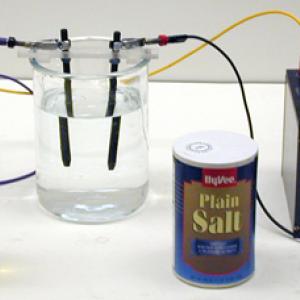College of Liberal Arts & Sciences
5D30.10 - Conductivity of Water
Place water that has been run through the filters into the battery jars so that the electrodes are sufficiently submerged. There should be no observed conductivity as shown with the light bulb. Pour in salt and the light will start to glow. This will take a lot of salt as it takes time for the salt to dissolve and diffuse. For this reason the acid may be the better choice in some cases as this problem does not occur.
The homemade conductivity probe can be used to observe the effect of ion concentration to conductivity in solutions.
Caution: Avoid acid burns and always unplug the power when moving the electrodes.
- Deborah F. Buffum, "Carbon Electrodes Improvised", TPT, Vol. 35, # 5, p. 315, May 1997.
- Ef-1: Freier and Anderson, A Demonstration Handbook for Physics.
- E-260: "Pigtail Socket - Salt Solution", DICK and RAE Physics Demo Notebook.
- Bassam Z. Shakhashiri, "9.31 - Electrical Conductivity of Liquids", Chemical Demonstrations, Vol. 3, p. 326.
- 70: "Electrolytic Titration", Chemical Demonstrations, Vol. 2, p. 132.
- Neil. A. Downie, "Electrolystor Amplifier", Ink Sandwiches, Electric Worms and 37 Other Experiments for Saturday Science, p. 160.
- Bobby Mercer, "Energy Drink Tester", Junk Drawer Chemistry, 2016, p. 110.
- W. Bolton, "The Electrical Conductivity of Sodium Chloride", Book 4 - Electricity, Physics Experiments and Projects, 1968, p. 9-10.
- W. Bolton, "Electrolytes", Book 4 - Electricity, Physics Experiments and Projects, 1968, p. 11-13.
- Rudolf F. Graf, "Electrolysis of Water", Safe and Simple Electrical Experiments, p. 83.
- Borislaw Bilash II, “Electrolytes and Nonelectrolytes“, A Demo A Day – A Year of Physical Science Demonstrations, p. 173.
Disclaimer: These demonstrations are provided only for illustrative use by persons affiliated with The University of Iowa and only under the direction of a trained instructor or physicist. The University of Iowa is not responsible for demonstrations performed by those using their own equipment or who choose to use this reference material for their own purpose. The demonstrations included here are within the public domain and can be found in materials contained in libraries, bookstores, and through electronic sources. Performing all or any portion of any of these demonstrations, with or without revisions not depicted here entails inherent risks. These risks include, without limitation, bodily injury (and possibly death), including risks to health that may be temporary or permanent and that may exacerbate a pre-existing medical condition; and property loss or damage. Anyone performing any part of these demonstrations, even with revisions, knowingly and voluntarily assumes all risks associated with them.
